When Manufacturing Moves from Liquids to Powder Products
As brands create powder-concentrate versions of their popular liquid products, they need to keep many operational differences in mind.
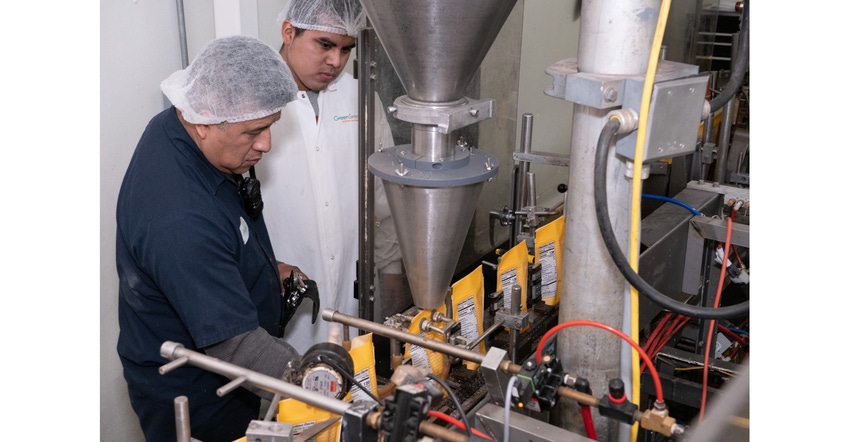
More food, beverage, and home-care brands are looking at switching from liquid formulations to concentrated powders in response to costs, changing consumer preferences, and a desire for more sustainable products and packaging.
Successful powder products in these categories — some newly formulated, and others long established — include Crush-brand beverages, baby formula, protein shakes, electrolyte drinks, pool chemicals, dishwasher and laundry pods, and even a foaming-powder toilet cleaner.
Moving to a powder formulation, or adding one to an existing product line, prompts many manufacturing, packaging, and logistics changes. Manufacturers must consider the effect on: filling and packing; outsourcing; supply chains; storage and transportation of ingredients and finished product; packaging design; and marketing, including ecommerce.
To understand these differences, we questioned five experts with expertise ranging from explosion safety to contract packaging. They are:
• Jeff Davis, senior explosion safety consultant for Fike Corp., which provides products and services for explosion and fire protection;
• Michael Keplinger, managing partner and director of testing and insights at branding agency SmashBrand;
• Neil Kozarsky, CEO of T.H.E.M., a packaging products and services provider;
• Scott Robison, vice president of business development at GreenSeed Contract Packaging; and
• Todd Smith, manager at Kansas State University’s Bulk Solids Innovation Center (KSU BSIC).
The panel’s answers, slightly edited, train a light on what it takes to make the move to powder products.
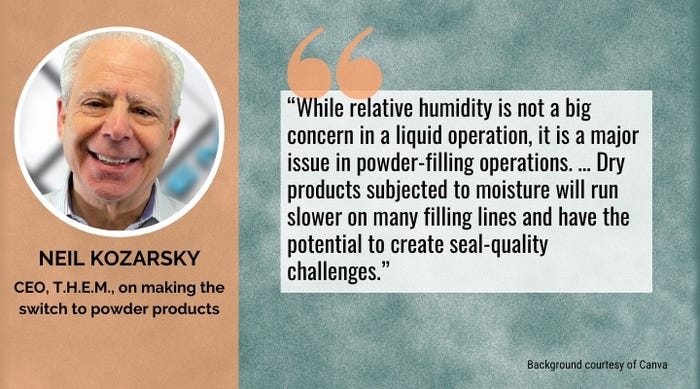
What are the impacts on packaging operations when switching from a liquid product to a powder product? What should a brand owner or contract packager be aware of when planning the switch?
Kozarsky (T.H.E.M.): When products change from liquid to dry, the packaging operations are very different, with the possible exception of secondary packaging. Primary packaging equipment for liquids is either incompatible with the packaging of powders or requires extensive change parts.
Microbiologically unstable liquid products typically need to be blended on-site, and liquid packaging operations often require thermal processing and hot or aseptic filling, which adds complexity and cost.
While relative humidity is not a big concern in a liquid operation, it is a major issue in powder-filling operations. Pumps and sanitary piping are replaced by hoists and/or pneumatic conveying when dealing with powders. Dry products subjected to moisture will run slower on many filling lines and have the potential to create seal-quality challenges. If the relative humidity is really askew, many products won’t run at commercially feasible rates.
Robison (GreenSeed): Besides different filling equipment, the storage requirements for liquid vs. powder are different, along with the way the product is fed to the filling equipment. It’s important to do your homework before planning the switch, as it will require more than just different equipment; it will require new operations, in most cases in a separate facility.
It’s important to do your homework before planning the switch, as it will require more than just different equipment; it will require new operations, in most cases in a separate facility.
Smith (KSU BSIC): Handling solids is often much more challenging than handling liquids. For example, to design a pump and piping system for liquids, all one needs to know is the viscosity and specific gravity of the liquid. But bulk solids are not nearly as predictable, especially if the bulk solid is a sticky powder, flows poorly, is degradable, segregates easily, or is susceptible to moisture or temperature issues. Equipment needs to be tailored to the specific material and application characteristics.
How does making this switch affect the supply chain?
Robison (GreenSeed): This really depends on the liquid, but moving to powder should simplify the packager’s supply chain.
Kozarsky (T.H.E.M.): Often liquid products need to be blended on-site or held under refrigeration, if shipped in bulk, due to microbiological concerns. The added cost implications can also become a consideration.
Dry products can be shipped in bulk from blending facilities to packaging operations with fewer concerns, potentially providing greater flexibility.
In both cases, temperature extremes and variations need to be avoided, and powders should be protected from high humidity environments, including during blending. To get a bit granular here, it should be noted that moisture-driven changes in [dry] product characteristics can necessitate the use of more expensive fill tooling. Volumetric is almost always less expensive than the use of augers.
... moisture-driven changes in [dry] product characteristics can necessitate the use of more expensive fill tooling. Volumetric is almost always less expensive than the use of augers.
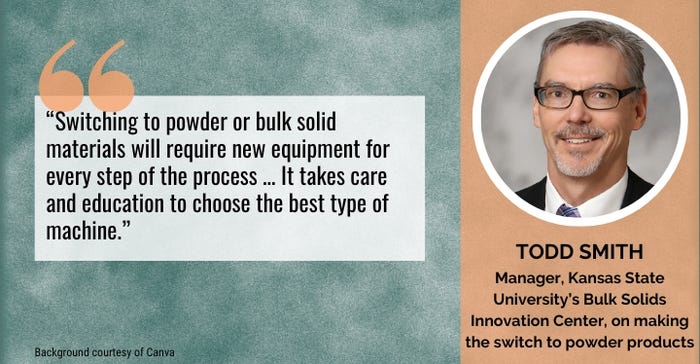
Smith (KSU BSIC): Switching to powder or bulk solid materials will require new equipment for every step of the process, including receiving and warehouse methods, conveyors, mixers, storage vessels or hoppers, dust collection and filters, feeders, and packaging machines. Fortunately, equipment suppliers are very good at designing equipment that will work well.
However, two big problems remain. First, many different types of equipment have been developed to handle the myriad of bulk solids, and so it is difficult to know which type is best. For example, there are many types of filling and packaging machines, with a variety of features, depending on the application. It takes care and education to choose the best type of machine.
The second problem is that each component may work well, but the transfers and interface points from machine to machine are equally challenging. For example, what do you do if material becomes segregated or won’t flow out of the feed hopper above the packaging machine? It is best to hire or consult with someone who has complete system experience, not just component experience.
How can a brand owner overcome the inherent operational challenges when switching from liquid to powder formulations?
Robison (GreenSeed): While most brand owners have separate facilities for powder and liquid packaging, for those that don’t, a switch from liquid to powder may be an opportune time to partner with a contract packaging. You cannot, for the most part, easily convert a liquid-filling operation to a powder-filling operation with the same packaging equipment.
A switch from liquid to powder may be an opportune time to partner with a contract packaging. You cannot, for the most part, easily convert a liquid-filling operation to a powder-filling operation with the same packaging equipment.
Does switching from liquid to powder affect outsourcing? If so, how?
Kozarsky (T.H.E.M.): Powdered products are more easily produced in a location that is remote from the packaging location, so outsourcing the packaging operation becomes easier with dry products.
Powdered products are more easily produced in a location that is remote from the packaging location, so outsourcing the packaging operation becomes easier with dry products.
If liquid products are not chemically preserved or naturally shelf stable, they either need to be blended on-site or shipped under refrigeration if moved to the packaging facility in bulk. So, again, dry products provide more flexibility.
Generally, the health and food-safety implications are less severe with dry products, resulting in more supply options for dry products. Conversely, liquid producers will require more food scientists and full-bore packaging engineers embedded in the process to ensure that needed compliance requisites are achieved. Sensitive as they are to cost variations, outsourcers must be mindful of these combined considerations and the possible effect on price.
Robison (GreenSeed): There are more contract packaging companies that can package powders vs. those that can package liquids. There should be more options to choose from when packaging powders.
There are more contract packaging companies that can package powders vs. those that can package liquids. There should be more options to choose from when packaging powders.
Brands should look for a co-packer that will truly be a partner in the growth of the company. Aside from specific certifications, look for a contract packaging organization with a good history and reputation, as well as on-time and on-budget project completion.
How does packaging-material testing change when filling powders vs. liquids?
Kozarsky (T.H.E.M.): The focus of barrier properties for liquid products is primarily oxygen barrier and puncture resistance. Liquid products will tend to spoil due to oxidation, and one “leaker” can ruin a significant amount of finished product. Also, one or two wet shipping cartons detected on a pallet can get an entire truckload rejected. Dry products primarily need moisture protection to avoid “clumping” and losing flowability.
Oxidation reactions happen much slower in a dry environment, so oxygen can be a lesser concern, depending on the fat/oil content of the product. Brands marketing liquid products often turn to process authorities and need to present extensive ladder logic evidence to validate the effectiveness of “kill steps” (a very popular packaging slogan when used at cocktail parties — not), and the safety of the finished good.
Micro leaks associated with dry products are, in many cases, not significant quality defects [nor] considered a basis for rejection. The microbiology of dry products is relatively easy to control and rarely results in significant quality defects or considered as a basis for rejection.
Does switching from a liquid formulation to a powder product affect how designers think about packaging design?
Keplinger (SmashBrand): When focusing on branding and messaging, switching from a liquid to a concentrated-powder product certainly requires a change in our approach to packaging design. While the benefits may be the same to the consumer, the change in product form completely alters the brand narrative and the perceived value by consumers. For instance, a powdered product may emphasize flavor choice, flexibility in portion control, or ease of use.
From a design perspective, much of this consideration comes from a very thoughtful look at these different aspects and how consumers would weigh decisions among a set of competitors that are commonly different in liquids vs. concentrated-powder products, even in the same category.
At SmashBrand, we delve into the consumers’ preferences and perceptions related to these different form factors. We understand that choosing between a liquid and a powder can drastically affect consumer behavior. Ultimately, we use a lot of carefully crafted consumer testing to uncover insights about consumer preferences to drive and inform designs that appeal to the right market segment.
We understand that choosing between a liquid and a powder can drastically affect consumer behavior.
As powders often face more competition than liquids, we must create designs that communicate a stronger value proposition and differentiate our clients’ products in unique ways. We focus on messages that resonate with the consumer’s lifestyle and consumption habits to ensure that the design effectively communicates the value proposition of the new form.
How would this kind of switch in product formulation affect product marketing?
Keplinger (SmashBrand): The switch from liquid to powder has significant implications for product marketing. The powder form presents different benefits and challenges a brand must address in its marketing strategy.
We start with a deep understanding of consumer behavior and how the product fits into their lives. For instance, if consumers perceive liquid products as more convenient, our marketing efforts would emphasize powder’s convenience. We might highlight messaging like “perfect for on-the-go” or “just add water for a refreshing beverage.”
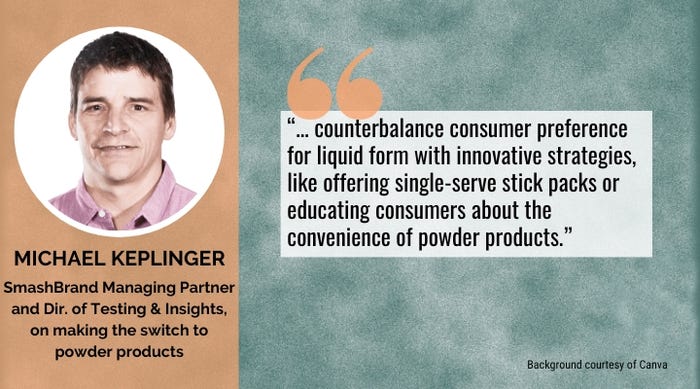
We understand the need to counterbalance consumer preference for liquid form with innovative strategies, like offering single-serve stick packs or educating consumers about the convenience of powder products.
Kozarsky (T.H.E.M.): From the brand owners’ perspective, it provides an opportunity to convey to the consumer that the amount of packaging and carbon footprint is less for dry products than for liquid products on a per-serving basis.
The opportunity for more sustainable packaging material is also potentially closer for dry products, as a moisture barrier is more attainable with the current renewable/compostable packaging materials than an oxygen barrier.
The opportunity for more sustainable packaging material is also potentially closer for dry products, as a moisture barrier is more attainable with the current renewable/compostable packaging materials than an oxygen barrier.
Would it affect ecommerce?
Keplinger (SmashBrand): Certainly. The switch from liquid to powder would present various ecommerce advantages, primarily due to supply chain benefits like longer shelf life, temperature insensitivity, and reduced shipping costs due to lower weight.
The switch from liquid to powder would present various ecommerce advantages, primarily due to supply chain benefits like longer shelf life, temperature insensitivity, and reduced shipping costs due to lower weight.
While consumers likely don’t care about these things directly all that much, this translates into a lower price per serving for the consumer, making the product more appealing. However, it’s not just about cost efficiency; we keep the consumer experience at the forefront, focusing on how the powdered product fits into their lives and usage habits.
While powders offer significant benefits, we understand the unbeatable convenience of grabbing a cold, ready-to-drink beverage at the checkout. So, we ensure that the marketing and branding of the powder product emphasize its convenience and other unique benefits in a way that resonates with the ecommerce audience.
At SmashBrand, we use our Path to Performance process, underpinned by data-driven consumer insights, to ensure our clients make this transition successfully and their products continue to resonate with their target audience.
Explosions and fire are special risk factors for powder packaging. Manufacturers of liquid products, particularly foods and beverages, may not realize how important it is to factor in these risks when switching to or adding a powder to their product lineup.
Explosions are a risk factor for powder-packaging operations. How do you assess the risk of explosions or fires occurring on these filling lines?
Davis (Fike): The first step is to determine if the powders are combustible. There [are dust-explosion characteristic values] for many common powders from the National Fire Protection Association (NFPA) and other sources. If data for the specific powders being handled cannot be found in literature, then testing of the powders should be conducted.
If the powders are combustible, then the next step would be to complete a Dust Hazard Analysis (DHA). NFPA 652 Standard on the Fundamentals of Combustible Dust requires DHAs for existing processes and as part of the design and installation of new processes.
If the new process requires building permits, the city or municipality may require a DHA prior to issuing permits. A proper DHA will assess the risk of explosions and fires from the powder process and will recommend safeguards where necessary [including safety systems and/or filtration systems].
A proper DHA will assess the risk of explosions and fires from the powder process and will recommend safeguards where necessary ...
How can brand owners and contract packagers mitigate the risk of explosion?
Davis (Fike): There are two types of controls for mitigating risks: administrative controls and engineering controls.
Administrative controls can include things like housekeeping, to prevent hazardous dust accumulations, and preventative maintenance/inspections, to reduce potential ignition sources from mechanical malfunction or overheating equipment.
Engineering controls can include controls for fugitive dust or ignition-source reduction, but what this most often means is explosion protection and isolation. Where there is an inherent risk of a dust explosion in equipment, explosion protection is needed. The two most common methods are explosion venting and explosion suppression.
Where there is an inherent risk of a dust explosion in equipment, explosion protection is needed. The two most common methods are explosion venting and explosion suppression.
The other requirement for explosion protection is isolation, which prevents the explosion from propagating to interconnected equipment.
Explosion venting is covered by NFPA 68. Explosion suppression and isolation, as well as other protection methods, are covered by NFPA 69.
Kozarsky (T.H.E.M.): Explosions are indeed a risk, so care must be taken. Filling hoppers should be sealed to minimize powder “escape,” and the production area needs to be effectively ventilated and monitored to avoid the buildup of excessive dust in work areas.
The filling operation itself tends to produce a certain amount of unavoidable dust, so the ventilation requirement becomes very important. The product development cycle for dry products often sees “minor” changes along the way that can cause severe deviations in fill speeds and dosing complexity.
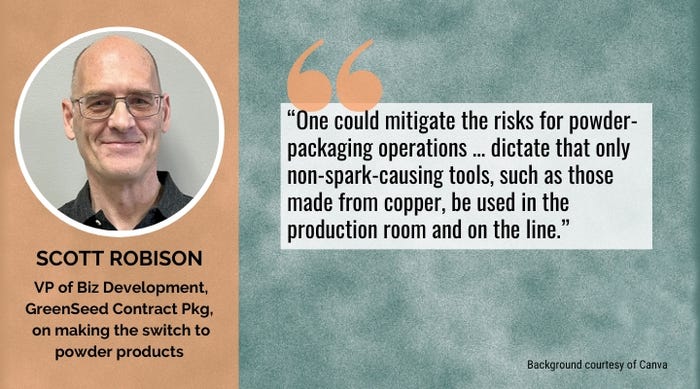
Robison (GreenSeed): One could mitigate the risks for powder-packaging operations through extensive dust collection; thorough sanitation of the production room, including walls, ceilings, and electrical equipment; and building a backblast room, if needed.
You can also dictate that only non-spark-causing tools, such as those made from copper, be used in the production room and on the line.
Smith (KSU BSIC): First, the process owner must determine if the material is at risk for dust explosions or dust inhalation. If so, then proper design, hygiene, and dust control must be used along with prevention and mitigation devices. The keys are education on the topic, then working with good suppliers and consultants to ensure safety.
What regulations should packagers be aware of when planning the switch from liquids to powders?
Davis (Fike): In the United States, the combustible dust standards are issued by NFPA. I referred to NFPA 652 above, which is the Standard on the Fundamentals of Combustible Dust.
There are specific commodity standards for different industries such as food and agricultural dusts (NFPA 61), metals (NFPA 484), wood products (NFPA 664), and then a general catch-all for other industries (NFPA 654). There are also the standards for the protection systems mentioned above, NFPA 68 and NFPA 69.
There is an OSHA regulation for Grain Handling Facilities (29 CFR 1910.272), and OSHA has a National Emphasis Program (NEP) for combustible dust, but otherwise OSHA has no specific regulations on combustible dust and instead will [use] the NFPA standards.
OSHA has a National Emphasis Program (NEP) for combustible dust, but otherwise OSHA has no specific regulations on combustible dust and instead will [use] the NFPA standards.
Would plant employees typically need to wear more or different personal protective equipment when working on a powder-packaging line (vs. a liquid-filling line)?
Davis (Fike): Potentially, additional personal protective equipment (PPE) may be required. If employees have the potential for exposure to flash-fire hazards, then flame-resistant clothing may be required.
If there are powders with low minimum ignition energies (MIE), then there may be a need for personal grounding, either through straps or special footwear. While not specifically related to powder vs. liquid, a review of the safety data sheet (SDS) for the material should be conducted any time there is a change in materials to determine if additional PPE is needed (for example, respirators, gloves, or protective eyewear).
Do employees require special safety training to work on a powder-packaging line?
Davis (Fike): NFPA 652 does require general safety training and hazard-awareness training for combustible dust for all affected employees.
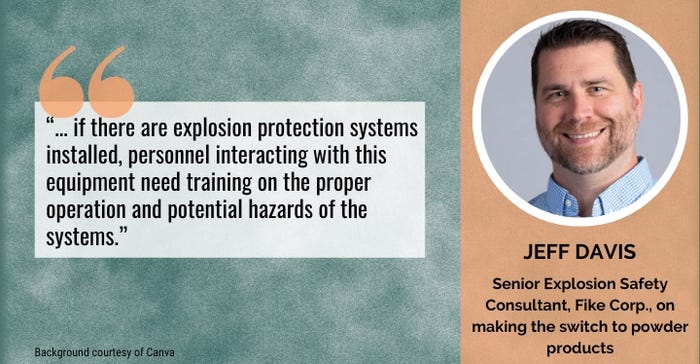
Job-specific training is required where there are specific hazards to the employees beyond what is addressed in the hazard-awareness training. For example, maintenance personnel would need specific training on how to open and safely work on equipment where dust hazards may be present. Additionally, if there are explosion protection systems installed, personnel interacting with this equipment need training on the proper operation and potential hazards of the systems.
About the Author(s)
You May Also Like




